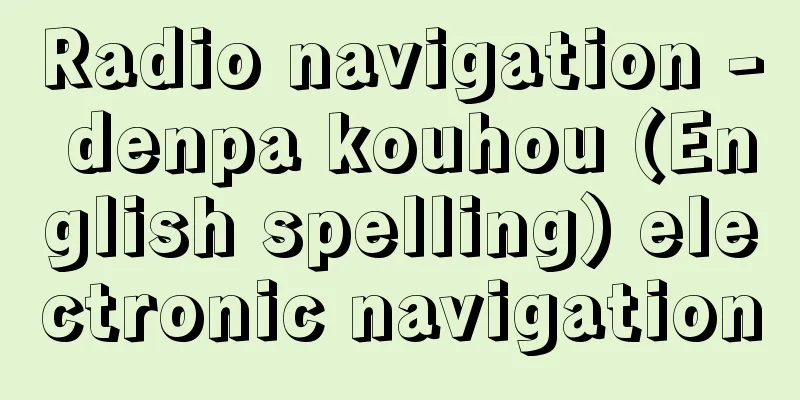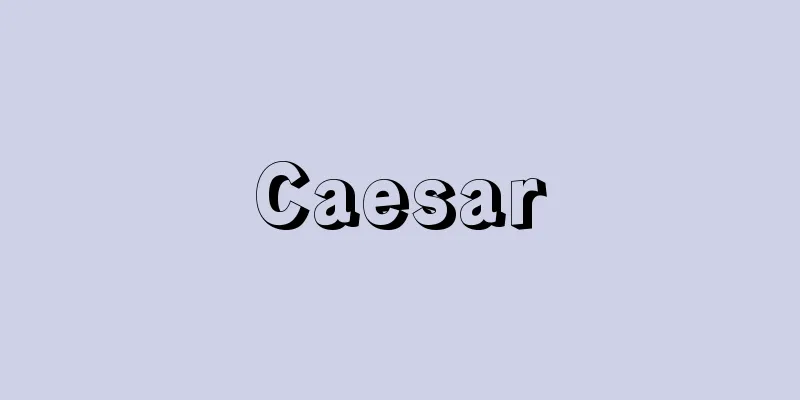Radio navigation - denpa kouhou (English spelling) electronic navigation

|
A general term for navigation for ships and aircraft that utilizes the straightness, constant speed, and reflective properties of radio waves. Because it uses radio waves with wavelengths much longer than visible light, there is little attenuation during propagation, and it can be used at night or in bad weather. It is also called electronic navigation. Radio direction signals began to be used in the 1920s, and various positioning methods were developed significantly after World War II. Currently, the methods widely used on ships can be broadly divided into the following: (1) A method of measuring the direction of a transmitting station by using the straightness of radio waves. Radio direction signals are one such method. This is a method of measuring the direction of arrival of radio waves using a radio direction finder that uses the directional characteristics of a frame-type antenna. There are two types: when a ship measures the beacon radio waves emitted from a radio beacon station installed on land (called ship-based radio direction), and when a land-based direction-finding station measures the direction of the radio waves emitted from the ship and reports the results (called land-based radio direction). The position line based on ship-based radio direction is an iso-azimuth curve that measures the radio beacon station on the measured direction, while the position line based on land-based radio direction is a great circle that intersects with the radio direction-finding station at the measured angle, and the nature of the two is essentially different. Radio direction signals use medium waves, which have various errors and low accuracy of direction measurement, and the range of use is short, only 50 to 100 nautical miles from the station, so both are changed to elongated directions and the ship's position is determined by the cross-azimuth method. Now that more accurate positioning methods than radio direction signals are available, they are more often used for rescue of ships in distress and for returning to port for whaling than for determining the ship's position. Course beacons using microwaves also fall into this category. (2) A method of measuring the distance difference from two stations by utilizing the constant speed of radio waves. This is a positioning method used by Loran, Decca, Omega, etc. The locus of points with a constant distance difference from two fixed points is a hyperbola with the two points as foci, so if the distance difference from the two transmitting stations is known, the position line is determined in the form of a hyperbola. This type of positioning method is collectively called the hyperbolic system. There are two methods for measuring distance difference: a method that uses shock waves to measure the arrival time difference of radio waves from two stations in microseconds (Loran), and a method that uses continuous waves to measure the phase difference in units of 1/100 of a cycle (Decca, Omega). Since it is impossible to write the hyperbola corresponding to the measured time difference or phase difference on a nautical chart every time, Decca charts, Loran charts, etc., in which a group of hyperbolae is overprinted on the chart at appropriate intervals, are published. The navigator simply needs to find two hyperbolae from two sets of stations and determine the ship's position as their intersection. The effective distance varies depending on the frequency of the radio waves used, the distance between stations, transmitting power, time of day, location relative to the station, and the required accuracy, so it is difficult to generalize, but Loran A is 700 to 1,200 nautical miles, Loran C is about twice that, Decca is about 250 nautical miles from the main station, and Omega is less reliable. (3) A method of measuring the direction and distance of a target by using the straightness, constant speed, and reflectivity of radio waves. Radar is one such example. It is a device that emits microwave pulses from a directional rotating antenna (scanner) attached high on the ship, receives reflected waves from land and other ships, and displays them on a cathode ray tube to determine the direction and distance to the target. Since a cathode ray tube with a long afterimage time is used, the initial image remains even after one rotation of the scanner, so it has the advantage of being able to see the entire circumference around the ship at the center at the same time. The effective distance varies depending on the height of the scanner, the wavelength used, the type of target, etc., but radar used on ships is up to about 40 nautical miles. Since it can display images even at night or in fog, it can be used to measure position while sailing along the coast, to keep watch whether on the coast or in the ocean, and to avoid collisions with other ships, making it the most effective radio navigation device for navigators. In addition, the Doppler effect can also be utilized when the relative velocity change between the transmitting and receiving stations is extremely large. [Fumihiko Kawamoto] [References] | | | | |Source: Shogakukan Encyclopedia Nipponica About Encyclopedia Nipponica Information | Legend |
|
電波の直進性、定速性、反射性を利用する船舶や航空機の航法の総称。可視光線よりはるかに波長の長い電波を利用するので、伝播(でんぱ)中の減衰が少なく、夜間や悪天候でも使用できる。電子航法ともいう。 1920年代から無線方位信号が使われ始め、第二次世界大戦を契機として各種の測位方式が著しく発達した。現在、船舶で広く用いられている方式を大別すると次のとおりである。 (1)電波の直進性を利用して発信局の方位を測定する方式 無線方位信号がこれにあたる。枠型空中線の指向特性を利用した無線方位測定機で電波の到来方向を測る方式である。陸上に設置された無線標識局から発射される標識電波を船で測定する場合(船測無線方位という)と、船から発射する電波の方向を陸上の方向探知局で測定してもらい、その結果の通報を受ける場合(陸測無線方位という)の2種がある。船測無線方位による位置の線は無線標識局を測定方位に測る等方位曲線であり、陸測無線方位による位置の線は無線方向探知局と測定角で交わる大圏で、両者の性質は本質的に異なる。無線方位信号の使用電波は中波で、各種の誤差があって方位測定精度も低く、利用範囲も局から50~100海里と短いので、ともに漸長方位に改めて、交差方位法によって船位を決定する。 無線方位信号よりも高精度の測位方式が用いられるようになった現在では、船位測定よりも遭難船救助や捕鯨などの帰投用に用いられることのほうが多い。マイクロ波を用いるコースビーコンもこの分類に入る。 (2)電波の定速性を利用して二局からの距離差を測定する方式 ロラン、デッカ、オメガなどの測位方式である。二定点からの距離差が一定な点の軌跡は、その2点を焦点とする双曲線であるから、二発信局からの距離差がわかれば双曲線の形で位置の線が決定される。このような測位方式を一括して双曲線方式hyperbolic systemという。距離差測定法には、衝撃波を用いて二局からの電波の到達時間差をマイクロセカンド単位で測定する方式(ロラン)と、持続波を用いて位相差を100分の1サイクル単位で測定する方式(デッカ、オメガ)の二法がある。測定時間差または位相差に対応する双曲線を、そのつど海図に記入することは不可能であるから、適当な間隔で双曲線群が海図に重ね刷りされたデッカ海図、ロラン海図などが出版されている。航海者は二つの組局から2本の双曲線を求め、その交点として船位を決定すればよい。有効距離は使用電波の周波数、組局間の距離、送信出力、昼夜、局との関係位置、要求精度などによって異なり一概にはいえないが、ロランAが700~1200海里、ロランCが約2倍、デッカは主局から約250海里程度で、オメガは信頼度が低い。 (3)電波の直進性・定速性・反射性を利用して物標の方位・距離を測定する方式 レーダーがこれにあたる。船の高いところに取り付けた指向性回転アンテナ(スキャナー)からマイクロ波のパルスを発射し、陸地や他船からの反射波を受信してブラウン管に表示して、物標までの方位と距離を知る装置である。残像時間の長いブラウン管を使用して、スキャナーが1回転しても初めの映像が残っているので、自船を中心とする全周が同時に見られる利点がある。有効距離はスキャナーの高さ、使用波長、物標の種類などによって異なるが、船で用いるレーダーは40海里ぐらいまでである。夜間や霧中でも映像が示されるので、沿岸航行中の位置測定や、沿岸、大洋を問わず見張り、他船との衝突回避に利用でき、航海者にとってもっとも有効な電波航法装置である。 このほか、発信局と受信局の相対速度変化がきわめて大きい場合は、ドップラー効果も利用できる。 [川本文彦] [参照項目] | | | | |出典 小学館 日本大百科全書(ニッポニカ)日本大百科全書(ニッポニカ)について 情報 | 凡例 |
<<: Radio noise - denpazatson (English spelling)
>>: Booster - denbakuyaku (English spelling)
Recommend
Schurz, C.
…He was a professor at the University of Bonn and...
Ureshino [town] - Ureshino
An old town in Fujitsu District, southern Saga Pre...
eidos
…Originally a Greek word meaning “see” or “appear...
Wang Fengchang
…Grandson of Wang Xijue, the prime minister of th...
Åland (English spelling)
…the archipelago is located in southwestern Finla...
Open Course
Open course is a type of track used in track and f...
Albazin (English spelling) Албазин/Albazin
A Russian fortress located about 450 km upstream f...
Biot-Savart's law
This law describes the magnetic field generated by...
Superfinishing - Choushiage (English spelling)
A mechanical surface finishing method. Polishing ...
Pilea hamaoi (English spelling) Pilea hamaoi
…[Tetsuichi Yahara]. … *Some of the terminology t...
Malinke people - Malinke (English spelling)
A tribe living in West Africa across Guinea (1 mil...
samsinhalmŏni (English spelling) samsinhalmoni
…In addition to the Uchigami, who are worshipped ...
Shibuya
The area is located in the southern part of Shibu...
Ohashi Souko
1576-1654 A shogi player from the early Edo perio...
Cirsium japonicum (English name) Cirsiumjaponicum
…[Hiroshi Aramata]. … *Some of the terminology th...









